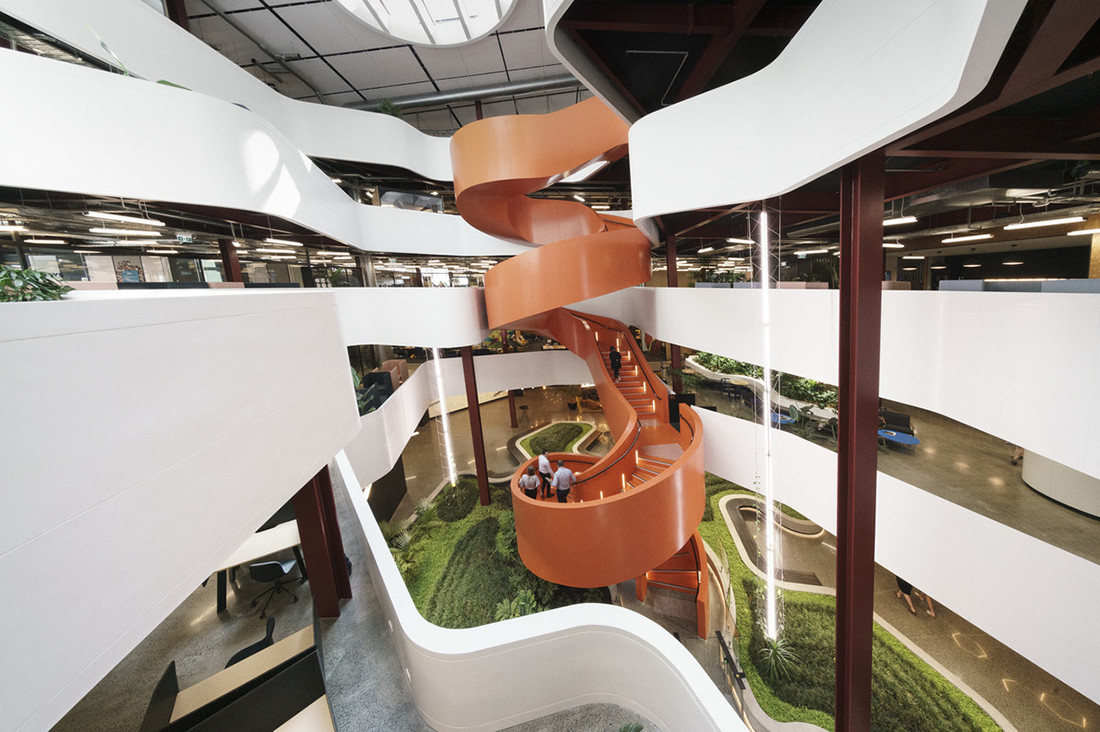Designed by BVN in association with Jasmax, B:Hive Smales Farm is a vibrant workplace for businesses to thrive.

December 17th, 2019
“Cross-pollination” is a buzzword in business today, as people, departments and businesses work together to conceive and achieve bigger and better ideas. Contemporary offices, particularly co-working spaces, are being designed to support and promote this cross-pollination. B:Hive Smales Farm in Auckland, New Zealand, is one award-winning example. Designed by BVN in association with Jasmax, the new office building is attracting individuals, start-ups and small- to medium-sized companies that want to be part of a buzzing, collaborative community.

In less than three decades, Smales Farm in Takapuna has been transformed from farmland to twentieth-century office park and is now on its way to twenty-first-century urban hub. B:Hive is the first step in creating this urban hub, with an engaging environment based on three tenets of development today: community, sustainability and technology. B:Hive is the largest purpose-built co-working facility in the Southern Hemisphere and was voted “Best Office in the World” at the 2019 World Architecture Festival.

An atrium and staircase at the heart of the building help foster the thriving, collaborative work community. Evocative of a theme park ride or waterslide, the orange staircase twists and turns between the levels and is bathed in natural light, inviting people to ascend or descend it. “The connecting stair is located close to the entry, encouraging people to walk through the building rather than the lift, and providing opportunities to engage, meet, observe and participate,” says BVN Principal James Grose.

With sustainability and workers’ wellbeing in mind, the skylight above the atrium brings natural light into all levels. Thermal chimneys in the façade draw air through the atrium to ventilate the interior, and a garden at the base of the staircase adds greenery and helps purify the air.

The stair and atrium connect the ground-floor meetings rooms and event space with the work areas that spread across fives levels. The interior edge of each level is wrapped with white MDF that accentuates it curvaceous form. Circling around and projecting into the atrium, these curves provide different vantage points and create organic spatial arrangements.

Moveable walls allow businesses with the flexibility to upsize, downsize and move desks as needed, and open-plan desks allow solo practitioners and small companies to join forces in sitting or collaborating together. Informal meeting and lounge areas throughout B:Hive provide various spaces to suit people’s diverse working needs.

The fluidity in the architecture of B:Hive reflects the fluidity needed in business today. Providing a vibrant workplace for start-ups, businesses and solo practitioners, B:Hive supports and encourages their ideas to pollinate and propagate.
If you liked this article we think you’ll love Inside DCM’s office. And for all the latest design insights, join our weekly newsletter.
INDESIGN is on instagram
Follow @indesignlive
A searchable and comprehensive guide for specifying leading products and their suppliers
Keep up to date with the latest and greatest from our industry BFF's!

BLANCOCULINA-S II Sensor promotes water efficiency and reduces waste, representing a leap forward in faucet technology.

XTRA celebrates the distinctive and unexpected work of Magis in their Singapore showroom.

In design, the concept of absence is particularly powerful – it’s the abundant potential of deliberate non-presence that amplifies the impact of what is. And it is this realm of sophisticated subtraction that Gaggenau’s Dishwasher 400 Series so generously – and quietly – occupies.

Within the intimate confines of compact living, where space is at a premium, efficiency is critical and dining out often trumps home cooking, Gaggenau’s 400 Series Culinary Drawer proves that limited space can, in fact, unlock unlimited culinary possibilities.

How can design empower the individual in a workplace transforming from a place to an activity? Here, Design Director Joel Sampson reveals how prioritising human needs – including agency, privacy, pause and connection – and leveraging responsive spatial solutions like the Herman Miller Bay Work Pod is key to crafting engaging and radically inclusive hybrid environments.

Australian curator, writer and educator Kate Goodwin has been in attendance at the 2025 Venice Architecture Biennale and reports back on some of the highlights.
The internet never sleeps! Here's the stuff you might have missed

Don’t miss your chance to be part of Sydney Open 2025! Submit your Expression of Interest for this year’s city-wide event by Friday, 9 May.

Stephen McGarry redefines architecture as an emotive and contextual artform, blending storytelling, material sensitivity, and cultural memory in his shortlisted Bruce Street project.